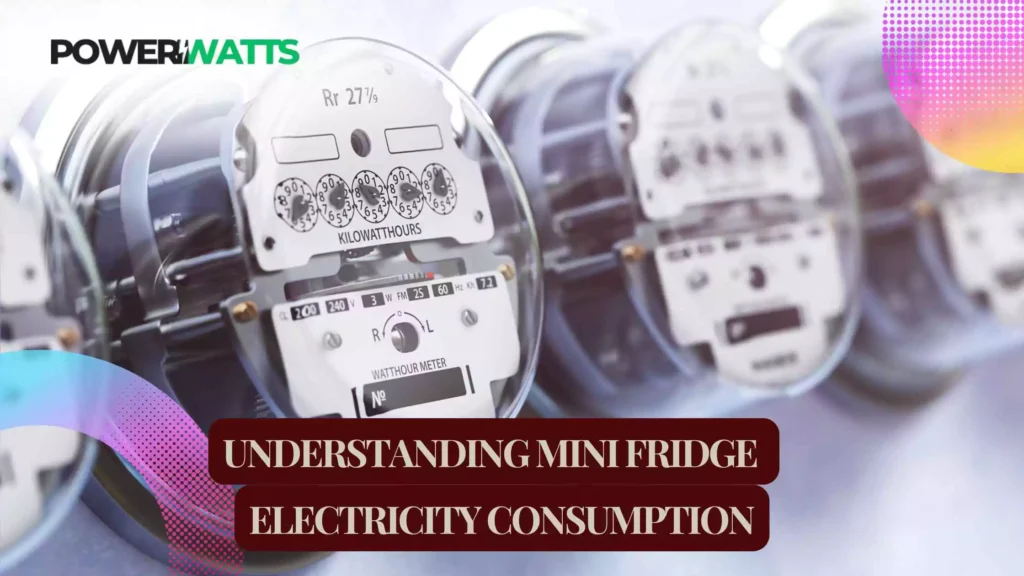Anyone who is thinking about getting a small fridge for their home or office needs to know how much electricity it uses. This guide will explain the things that affect how much mini fridge electricity consumption is, give you ways to figure out how much it will cost and give you good ideas for saving energy. We will also talk about important things to think about when picking a solar generator to power your small fridge.
How Much Electricity Does A Mini Fridge Use?
There are a lot of different things that can affect how much power small fridges use. Take a closer look at what makes them use more or less energy, especially when considering options like the California PPA program bill, which can help lower overall electricity costs by incorporating solar energy solutions.
Average amount of power used
- Most small fridges use between 50 and 100 watts of electricity when they are not being used. This can go up, though, when the model first starts up, when it might need up to 280–360 watts. To better understand this, think about these things:
- Wattage for running: Most small fridges need between 70 and 100 watts of power.
- Startup power: This can be a lot more than the working power, usually two to three times as much.
Calculating Daily Energy Consumption
Use this method to figure out how much energy you use each day:
- Daily Usage (kWh) = (Wattage × Number of Hours Used) / 1000
For instance, if your small fridge runs for eight hours at 90 watts:
The amount of power used each day is 90 watts times 8 hours
- Consumption per day = 1000
- 90 watts times 8 hours equals 0.72 kWh
Monthly And Yearly Costs
To figure out how much it will cost each month and each year based on the area power rate ($0.10 per kWh), Cost per month:
The cost per month is $0.72 per kWh times 30 days, which equals $2.16.
- Cost Per Month: $0.72 per kWh times 30 days, or $2.16
How much it costs each year:
- Annual Cost=$2.16×12=$25.92
Key Factors Affecting Mini Fridge Electricity Consumption
There are a few things that can change how much power your small fridge uses:
Type And Size
The fridge’s energy use is directly related to its size. To keep the temperature stable, bigger models need more power than smaller ones.
Age And Efficiency
Newer models usually use less energy than older ones because they have better ventilation and technology that is meant to use less power.
Temperature
The fridge’s performance can also be affected by where it is kept. A small fridge that is in a warm room will work harder than one that is in a cool room.
Effective Ways To Save Energy With Your Mini Fridge
Optimize Placement
This little fridge should be kept somewhere cool, out of direct sunlight, and away from heat sources like fires and ovens. This is what will make it work better.
Keep It Full
When the fridge is full, it keeps cold longer than when it’s empty, so the fan doesn’t have to run as often to keep the temperature stable.
Regular Maintenance
To get the best performance, clean the condenser coils often and make sure the door locks are tight.
Limit Door Openings
Keep the fridge door closed as much as possible and open it only a few times a week to keep the temperature inside stable.
Powering Your Mini Fridge With A Solar Generator
A solar generator is a great way to power your small fridge without using too much electricity from regular sources. The following tips will help you pick the best solar generator. When choosing a sun generator for your small fridge, keep these things in mind:
- Needs For Power: Find out how many watts your small fridge needs to run. Most models need between 70 and 100 watts to run and more when they first turn on.
- Size Of The battery: Pick a solar generator with a battery size that is high enough (in watt-hours) to meet the daily energy needs of your fridge. As a general rule, you should choose a generator that can handle at least 20% more power than you think you will need in a day.
- Solar Panels That Work Together: Check to see if the solar generator can connect to more solar panels. This can speed up the charging process and make it more efficient.
- Being Portable: If you’re going to use your generator outside or in an emergency, choose one that is small and easy to move around.
- Some Extra Features: For more ease, think about adding extras like built-in USB ports, LED lights, and more than one way to charge.
Conclusion
To effectively manage energy costs, it is important to know how much electricity a small fridge uses. You can enjoy the benefits of having a mini fridge without having to pay a lot for power if you figure out how much you use each day and each year and make plans to save energy.
Consider using a sun generator to power your small fridge if you want to do something good for the environment. You can have all the benefits of modern refrigerators while also having a much smaller effect on the environment if you choose wisely based on power needs, battery size, and other features.


